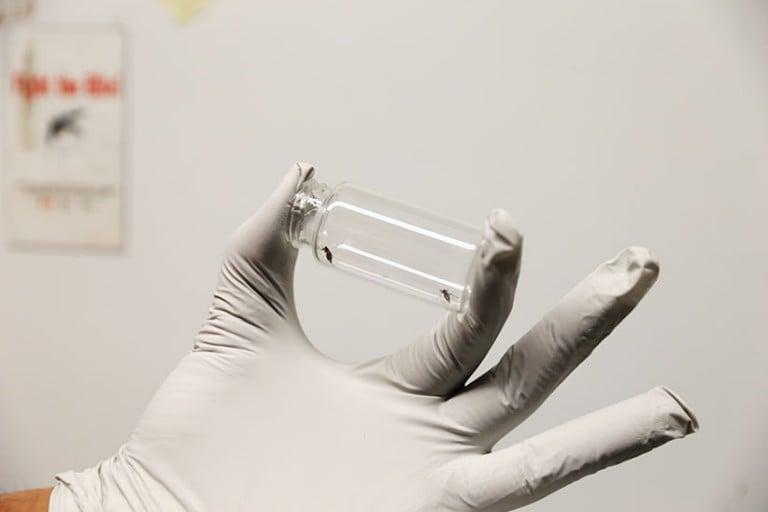Could Canadian mosquitoes transmit the Zika virus?
The common wisdom is that Canadian mosquitoes cannot transmit the Zika virus. The truth is that scientists don’t really know.

Studying mosquitoes in the Insectary at Brock University. (Photograph by Kayla Chobotiuk)
Share
In Canada, it’s easy to feel complacent about the ongoing Zika pandemic. As of Feb. 8, seven Canadians have been diagnosed with the virus, all of them travellers who visited regions where it was spreading (Zika is transmitting locally in 26 countries and regions in the Americas, including Brazil, Puerto Rico and Mexico). There’s no vaccine, no treatment or cure; emerging evidence suggests that Zika could be linked to birth defects in the babies of pregnant women who become infected. Public health officials have repeatedly said there’s little to no chance the virus will spread locally in Canada. The type of mosquito that transmits it, called Aedes aegypti, doesn’t live here: it’s too cold. Even the World Health Organization—which recently declared a global public health emergency over Zika’s rapid spread in the Americas—predicts that Canada will be spared. According to Fiona Hunter, a medical entomologist at Brock University in St. Catharines, Ont., that could be premature. The common wisdom is that our mosquitoes can’t transmit Zika. In reality, she says, “We have no idea.”
Hunter, who was instrumental in identifying which types of mosquito transmit the West Nile virus when it first hit Ontario, some 15 years ago, studies local bugs to see if they’re capable of spreading emerging diseases. Ontario alone has 67 mosquito species. “Some of them don’t blood feed, so they’re not on the radar,” she explains. “But about a dozen, we know, can vector other diseases.” She recently received approval to study Zika in her containment lab at Brock, the only one in Canada certified to hold infected insects, other than the Public Health Agency’s National Microbiology Lab in Winnipeg. In rare cases, Zika can be sexually transmitted (one Texas patient recently became ill with a sexually acquired infection). The Aedes aegypti mosquito, which also spreads dengue and yellow fever, has been largely blamed for the current pandemic; but in other parts of the world, many kinds of mosquitoes are known to spread Zika, Hunter says. Nobody has yet looked at Canadian bugs. “We have to see what our homegrown mosquitoes might be able to do.”

Until very recently, researchers weren’t overly interested in Zika. First discovered in Uganda in 1947, it generally causes only mild, flu-like symptoms (four in five people experience no symptoms at all). In 2015, after causing small outbreaks in islands along the South Pacific, the Zika virus began transmitting locally in Brazil, its jumping-off point in the Americas. There, health authorities noticed a troubling rise in diagnoses of microcephaly, in which babies are born with abnormally small heads and underdeveloped brains. Other emerging evidence suggests that Zika infection could lead to Guillain-Barré syndrome, a rare disorder that can cause paralysis and, in some cases, death. Scientists are working to determine whether Zika is indeed to blame for these, or other, conditions. Some say that the virus, which was long thought to be harmless, might have mutated into a more dangerous form.
A Maclean’s longread: How Zika went from ‘weenie’ virus to global health threat
Hunter will be studying Zika inside her containment lab at Brock, which has several security features to prevent contaminated insects from escaping—including negative air pressure, which sucks air from the hallway and sends it out through a sophisticated air filtration system. Before entering, researchers have to take off their street clothes and don scrubs. They shower before leaving. Nothing can exit the space without being decontaminated. “There’s no risk [infected insects] will ever get out,” Hunter says. “They’d have to fly upwind, through five doors.” In a separate lab space, one floor down, her team hatches “clean” mosquitoes, which can later be infected for study. They’ll also catch mosquitoes in the wild and bring them into the containment lab, to see whether they’re carrying pathogens. “My crew identifies about half a million mosquitoes every year,” Hunter says.
In 2002, Hunter and her team found a few Aedes albopictus mosquitoes in a trap in Niagara—another type of bug that’s been implicated in the spread of Zika. Aedes albopictus ranges as far north as New York and Chicago, but public health officials say it doesn’t live in Canada. “I never in a million years dreamed we’d see it up here,” Hunter says. Since that initial discovery, she’s been looking for more of them every year, but hasn’t seen any since. “It must have been a rare incursion,” she says. With climate change, though, mosquito species are moving farther north all the time. Invasive species frequently end up crowding out local ones, she says. In 2004, Hunter identified another mosquito called Aedes japonicus. “Within a decade, it had become the fifth-most common mosquito in Ontario,” she says. “Then we lost track of it, because it’s everywhere.” When it comes to bugs that might be able to spread Zika, she says that Aedes japonicus is “high on the list” of those she wants to study. A relative of Aedes aegypti, it’s a blood-biter that feeds on humans and mammals, and can transmit the West Nile virus, Hunter says. Spring will soon be here, and with it, mosquito season. “We’ve got a lot of species in the genus Aedes that are [active in] early spring, and are quite voracious biters,” Hunter says. “We want to get started on our research immediately.”